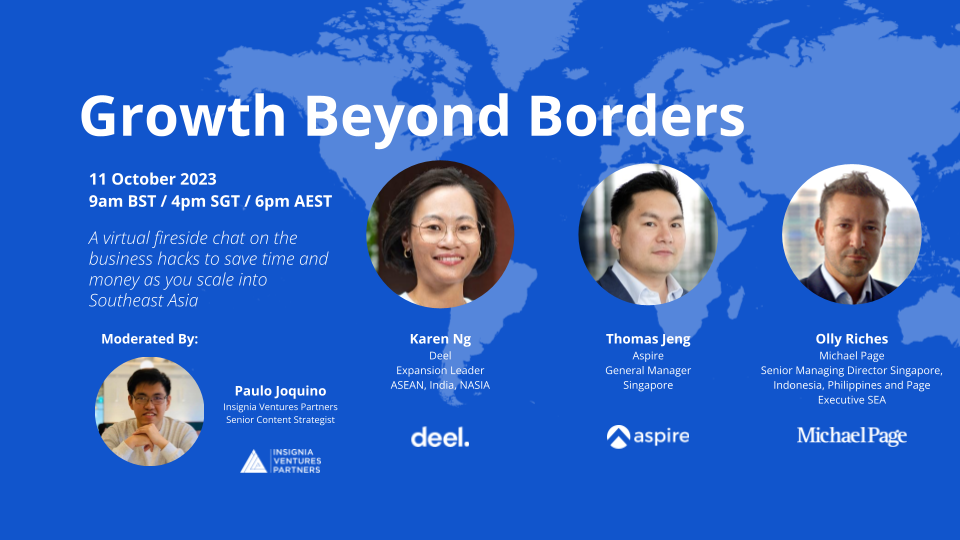There’s a growing phenomenon taking shape in the Southeast Asian startup landscape: the influx of Chinese tech entrepreneurs making Singapore their headquarters. This is a development taking place with the backdrop This shift isn’t merely an extension of existing enterprises; rather, it signals a more significant change in the competitive and investment landscape of the region.
While still bringing with them their deep networks to Chinese capital and experience working with engineering talent, these entrepreneurs are starting from Singapore to unlock untapped markets initially as a starting point to then build for the global market.
The phenomenon could be aptly termed “China in SEA 2.0,” and it’s contributing notably to the tech ecosystem, especially in deep tech sectors.
This influx is also supported by a “capital exodus” from China into emerging markets, with more than 10K HNWI’s moving out of China over the past year (more than 13K expected in 2023), and SFOs in Singapore climbing up from 700 in 2021 to 1100 in 2022, with significant contribution from the Chinese market.
The New Equation for the Global Company
Before, Southeast Asia (SEA) was often not considered an ideal location for creating a global tech firm. It used to be the case that Chinese entrepreneurs and CEOs would view emerging market regions like Southeast Asia purely as geographies for expansion.
Today, there’s a shift towards Chinese entrepreneurs now setting up bases in Singapore and using it as a launching pad for their global ventures. The new equation can be summed up as:
Singapore HQ + Chinese founders and engineers + Global market (including ASEAN markets)
There long-term opportunity here is the catalysis for tech and market maturity in Southeast Asia, especially in deep tech sectors like general AI.
Examples in Ecommerce and AI
Ecommerce Case Study
Alibaba and Tencent have been investing in local ecommerce, but newer entrants like TikTok Shop and Shein are altering the ecommerce landscape in the region. This talent influx acts as a catalyst for ecommerce innovation, contributing to an enabler layer that’s developing in ASEAN.
While an older example, the story of Konvy CEO QingGui Huang is an example of Chinese ecommerce entrepreneurial talent going into Southeast Asia in 2011 and pioneering ecommerce in Thailand’s beauty industry, specifically. Learn more about his story on our podcast.
AI Case Study
HQ in Southeast Asia: Founded in 2019, the company has benefited from Singapore’s supportive entrepreneurial policies like EntrePass and has got its first customer through IMDA’s support (as CEO Jennifer shares in this interview).
Chinese & Global Roots: The company is helmed by Jianfeng Lu (Chairman) and Jennifer Zhang (CEO).
Global Market: They have a broad range of clients, including 200 MNCs, Fortune 500 companies, and unicorns across 15 countries. They recently launched services in Latin America.
Catalyst for Technological Innovation: WIZ.AI has pioneered applications in customer engagement, primarily with their Talkbots for local languages and dialects. In the advent of generative AI adoption, they have also developed localized large language models (LLM) that could cater to specific enterprise use cases.
WIZ.AI’s LLM is an exemplary case of enterprise-level AI application, offering fast, secure, and robust data analysis capabilities. It signals the company’s commitment to the region and its vision for AI adoption in the SEA markets.
Having just launched an LLM for Bahasa Indonesia, they are already planning to extend its foundational LLM to other Southeast Asian languages, like Thai. The goal is to spur regional AI innovation while addressing last-mile AI adoption and delivery challenges across key industries.
China in SEA 2.0 is just one dimension of the global talent influx
The infusion of Chinese entrepreneurial talent into Southeast Asia, especially Singapore, is reshaping the region’s startup ecosystem. From ecommerce to deep tech sectors like AI, the impact is palpable and promises to mature the market significantly.
But this Chinese influx of talent and capital is just one dimension of it. We also write about global companies expansion into Southeast Asia and implications for startups.
And to learn more business hacks on global expansion when it comes to talent and finance, join us for this upcoming discussion with leaders from Deel, Aspire, and Michael Page this coming October 11, 4 pm SGT. Register here.

Growth Beyond Borders: Empowering Expansion – Business hacks to save time and money as you scale into Southeast Asia
Paulo Joquiño is a writer and content producer for tech companies, and co-author of the book Navigating ASEANnovation. He is currently Editor of Insignia Business Review, the official publication of Insignia Ventures Partners, and senior content strategist for the venture capital firm, where he started right after graduation. As a university student, he took up multiple work opportunities in content and marketing for startups in Asia. These included interning as an associate at G3 Partners, a Seoul-based marketing agency for tech startups, running tech community engagements at coworking space and business community, ASPACE Philippines, and interning at workspace marketplace FlySpaces. He graduated with a BS Management Engineering at Ateneo de Manila University in 2019.